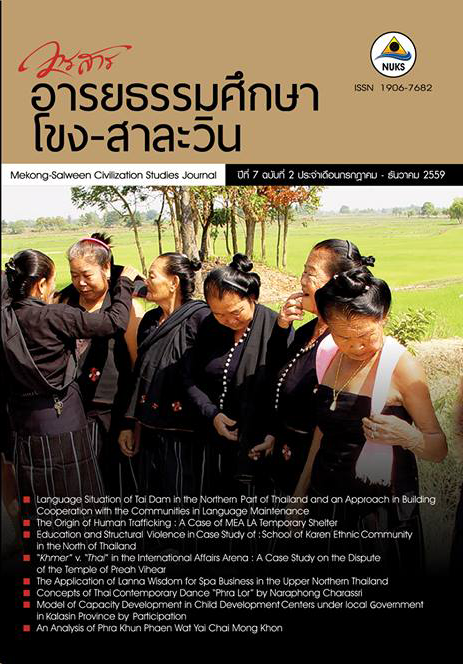Model of Capacity Development in Child Development Centers under local Government in Kalasin Province by Participation
Main Article Content
Abstract
This study mainly aims in 3 distinctive areas:to observe the
operation of child development centers subordinated to local
administration of Kalasin province along with the capacity of their personnel,
to create participatory models of the child development centers, and to
further develop into the child development center guidebook in practicing
participatory models. As mentioned above, the research data for the
operation is collected by sampling 210 local child development centers.
And, the research data for developing the models is done by working
closely with 11 experts. Moreover, the model trials and its evaluation to
the child development centers are exemplified by 6 children.
As a result, the overall operation of child development centers
subordinated to local administration of Kalasin and the capability of their
personnel are performed in a medium level. However, the real practice
of the child development center is represented in a relatively low level
as teachers are unable to advice the parents about proper nurturing.
From this, the suggestive solution is that the teachers must have discussed
and shared talking with parents more often and continuous, especially
in special occasions. Also, there should be a project of a home visiting in
order to seek ways of home nurturing. These solutions would help engaging
knowledge exchange between the three parties and it would encourage
a better understanding in children development. This is important because
every parties involved must realize to accept and to corporately responsible
to help children development achieved. Furthermore, it would strengthen
relationships as the teachers become more friendly to parents and children.
This is because the parents would trust and respect more the teachers
to discipline the children and it would lead to a satisfied result of children
development. More importantly, the study found that in order to fully
develop the children development centers, the executives involved
should plan educational development projects by setting clear visions,
responsibilities, and objectives which conform the development of the
centers itself by managing sufficient budgets reasonably to all.
Then, the participatory models of child development centers
subordinated to local administration of Kalasin consist of 6 main areas
which are management, human resource, building, environment and
safety, academic and curriculum activities, participations and supports,
and children development networking. To emphasize, the participatory
is divided to 5 points: participating discussion, participating planning,
participating decision, participating action, participating follow up, and
participating evaluation. Therefore, the effectiveness of models, mainly
focus on the executives is likely to be high.
Finally, the child development centers guidebook in practicing
participatory models and its evaluations of the guidebook appropriateness
are well structured to be in high to highest possibility. From the trials on
the children, it demonstrates that all personnel and the children of the
centers understand the usage and reflect its importance of participating
discussion, participating planning, participating decision, participating action,
participating follow up, and participating evaluation for the most effective
children development centers.


